Goldendoodle Colors: Uncover the Vibrant Range!
Embark on a colorful journey into the world of Goldendoodle colors! In this article, we delve deep into the vibrant spectrum of Goldendoodle coats, from the classic cream to the rare phantom. Discover how genetics, breeding, and care influence the multitude of hues these adorable dogs can exhibit. Whether you’re a potential Goldendoodle owner or a curious dog enthusiast, understanding the beauty and diversity of their coat colors will deepen your appreciation for this beloved breed.
Understanding Goldendoodle Coat Genetics
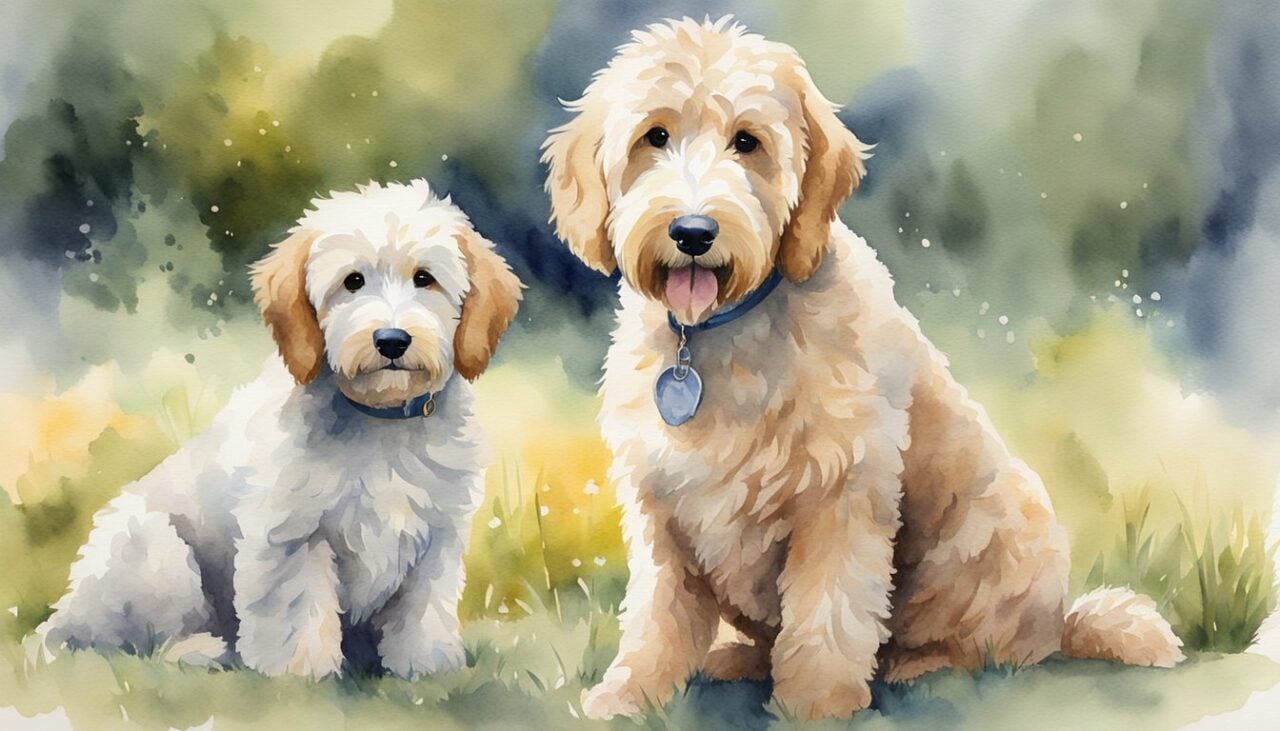
When exploring the diverse color palette of Goldendoodles, genetics play a pivotal role. Notably, the interplay of dominant and recessive genes and specific genes such as the merle gene influences the coat color outcomes, anchored by the breed’s origins from the Golden Retriever and Poodle parents.
Dominant and Recessive Genes
I understand that in Goldendoodles, coat colors and patterns arise from a combination of dominant and recessive genes. Dominant genes overpower their recessive counterparts, dictating coat color when present.
However, for a recessive color to be expressed, the puppy must inherit it from both parents. Genetic testing can help determine a dog’s genetic makeup, forecasting possible colors of offspring.
The Role of the Merle Gene
The merle gene creates a distinctive mottled coat pattern and is an example of a gene that is neither completely dominant nor completely recessive. This gene can create health complications if not bred responsibly.
When considering colors, a key point to note is that Goldendoodles can change colors from puppyhood to adulthood, with the merle gene playing a part in these transformations.
Influence of Parent Breeds on Coat
The influence of Goldendoodle parent breeds is significant. The Golden Retriever parent typically brings solid coat colors into the genetic mix, while Poodle parents introduce an assortment of colors and patterns, due to their wide genetic variety.
Understanding the coat genetics of these parent breeds can be crucial for predicting the appearance of their Goldendoodle offspring.
Primary Goldendoodle Coat Colors
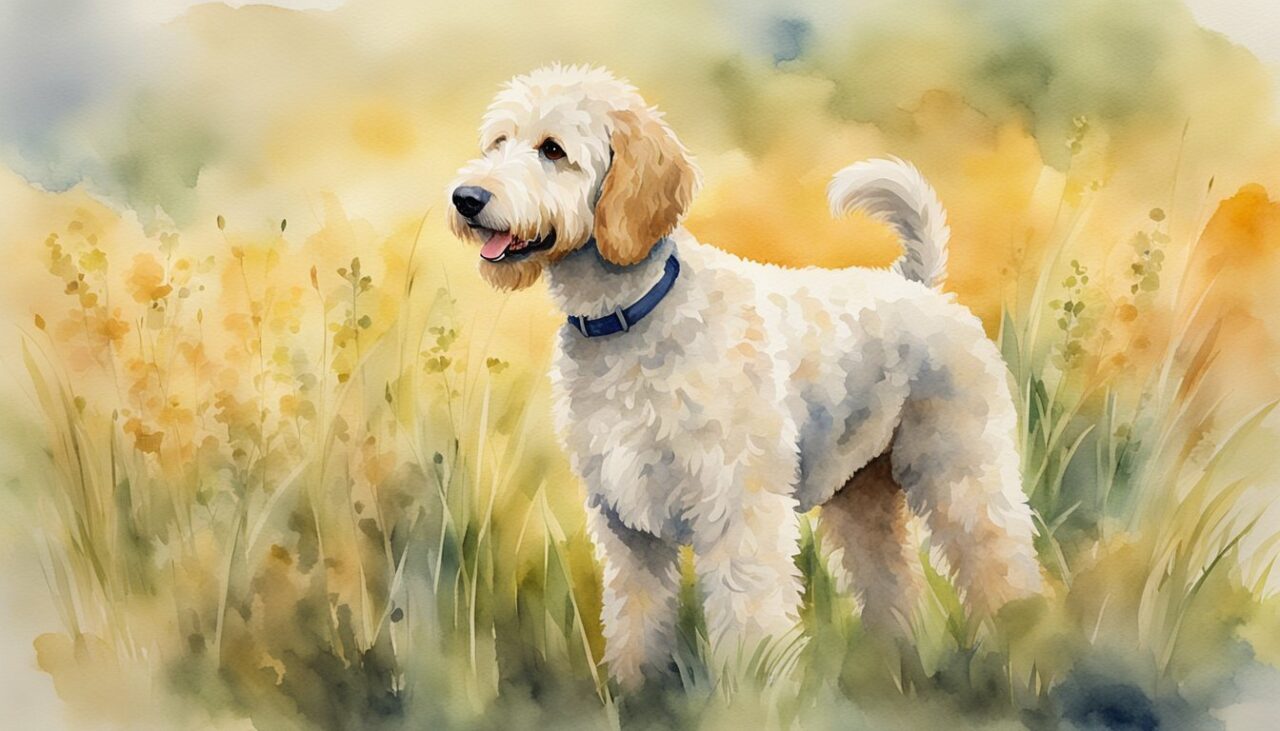
When discussing the primary coat colors of Goldendoodles, it’s essential to note the breed’s varied palette. As a combination of the Golden Retriever and the Poodle, Goldendoodles can inherit the rich spectrum of colors from both parent breeds. I’ll break down some of the most common colors you might see.
Black: A solid, striking color, the black Goldendoodle’s coat is a bold and uniform shade without other color markings.
Chocolate or Brown: Chocolate Goldendoodles can range from a deep, dark brown to a lighter, milk chocolate hue.
Cream: Cream Goldendoodles have a soft, light beige coat that often draws comparison to the pale shades of the Golden Retriever coat.
Apricot: A coat that carries warm, golden tones reminiscent of their Retriever lineage, apricot Goldendoodles possess one of the most sought-after hues.
Red: The red Goldendoodle boasts a vibrant, mahogany shade that truly stands out and can vary from deep to a lighter red.
White: Although less common, some Goldendoodles have a pure white coat, making them quite distinct within the breed.
These primary colors showcase the Goldendoodle’s diverse genetic makeup, which can also include various patterns and markings. The variation in coat colors is a charming aspect of this breed, ensuring that almost every Goldendoodle is unique in its appearance.
While I’ve listed some of the most prevalent colors, keep in mind that each Goldendoodle is individual, with its coat color being just one aspect of its unique charm.
Special Color Variations and Patterns
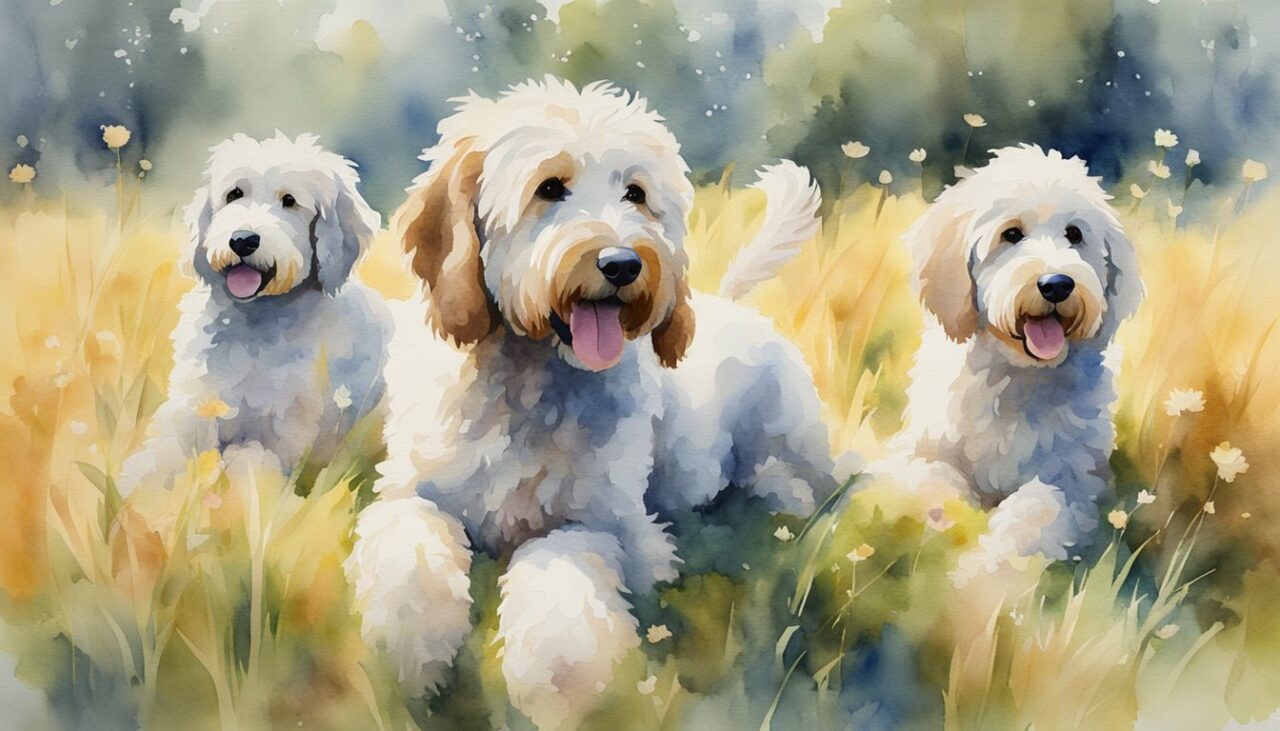
In the diverse world of Goldendoodles, certain color variations and patterns stand out for their uniqueness and genetic origins. These special features often mesmerize enthusiasts and potential owners alike.
Merle Goldendoodles
Merle refers to a pattern in a dog’s coat that is characterized by a distinctive mottling of colors, giving the appearance of patches and swirls. Merle Goldendoodles are particularly prized and can exhibit a vast array of colors that might include grays, blues, or varying shades of brown.
Each Merle Goldendoodle has a unique pattern, making them quite extraordinary to behold. However, potential owners should be aware that the merle gene can also affect hearing and vision, thus merle-to-merle breeding is discouraged to prevent health issues.
Parti Goldendoodles
Parti Goldendoodles have a coat displaying two distinct colors, with the parti gene giving rise to this captivating pattern. Typically, one of the colors is white while the other can be any color like black, brown, or gray, distributed in an irregular pattern across the body.
Parti Goldendoodles catch the eye due to this piebald appearance, which must cover at least 50% of their coat to be considered a true parti.
Abstract Goldendoodles
An Abstract Goldendoodle has a predominantly solid base color with patches of a different color, usually on the chest, paws, or face.
These dogs exhibit a minimal amount of their secondary color, not enough to qualify as a parti, but enough to distinguish them from their solid-colored counterparts.
Abstract coats can give a Goldendoodle a striking and unique appearance, standing apart in the doodle crowd.
Phantom Goldendoodles
The term “Phantom” describes Goldendoodles with phantom markings, which consist of a primary color with precise secondary markings in specific locations, such as above the eyes, on the sides of the muzzle, beneath the tail, and on the chest.
Phantom Goldendoodles can present a remarkable resemblance to the Doberman Pinscher’s coat pattern. Due to their distinct and sharply defined patterning, they personify an air of elegance and rarity in the Goldendoodle world.
This genetic expression is indeed fascinating and garners appreciation from those who are familiar with unusual color patterns in dogs.
Rare and Unique Goldendoodle Colors
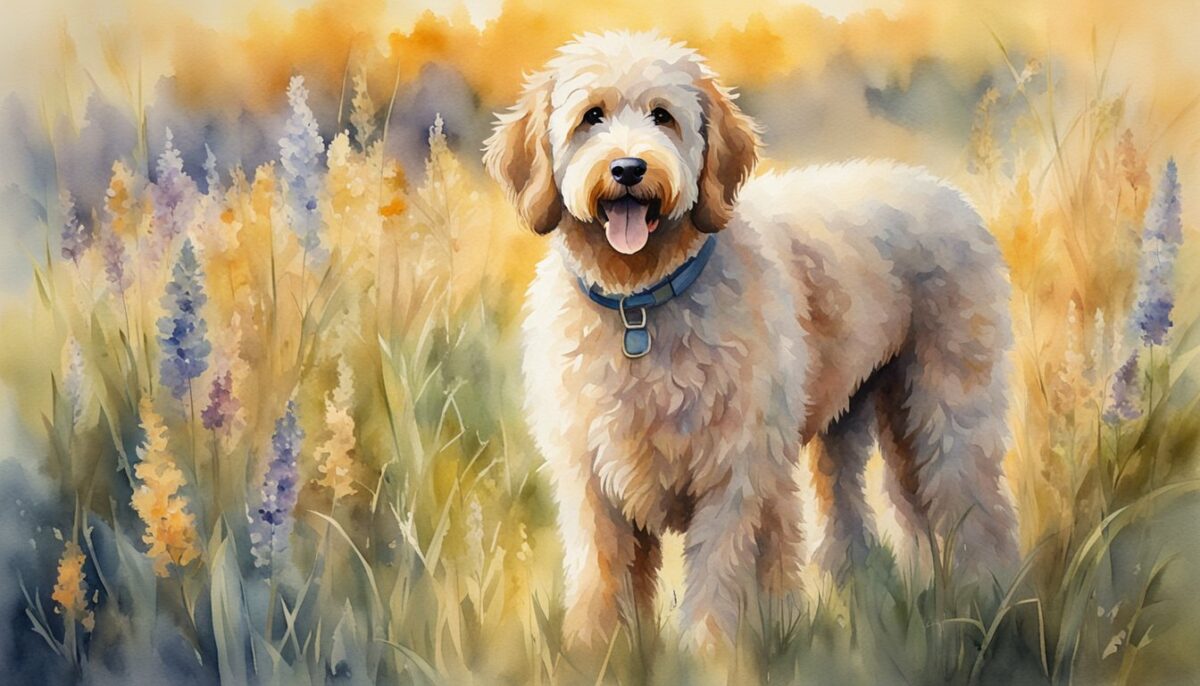
In the diverse world of Goldendoodle colors, several hues stand out due to their scarcity. As a Goldendoodle enthusiast, I’ve always been fascinated by the less common coat colors that these dogs can flaunt.
Among the rarest goldendoodle color variations, the dark chocolate coat is especially notable. Goldendoodles with this rich, deep coloring inherit their luxurious shade from their Poodle lineage.
Initially, the puppies might appear black or very dark brown, but as they mature, they often lighten slightly to reveal the true dark chocolate hue.
Another exquisite and rare color is silver beige. This particular shade takes some time to develop, as pups born with this color are typically darker at birth.
It’s a dynamic color, evolving as the dog grows older, and can best be described as a mixture of silver and a soft, creamy beige. Silver beige Goldendoodles are recognized by their elegant and unique coats that exude a metallic sheen, setting them apart from their counterparts.
| Color | Description | Rarity |
|---|---|---|
| Dark Chocolate | Deep brown with potential to lighten over time | Very Rare |
| Silver Beige | Blend of silver and beige, develops with age | Extremely Rare |
My experience with these colors tells me that they’re not just unique but also sought after for their aesthetic appeal, and finding a Goldendoodle with such distinctive shades can be quite a serendipitous event for dog lovers and breeders alike.
These shades are testament to the intriguing genetic lottery that takes place within the species, creating a captivating mosaic of canine beauty.
Influence of Coat Color on Goldendoodle Health
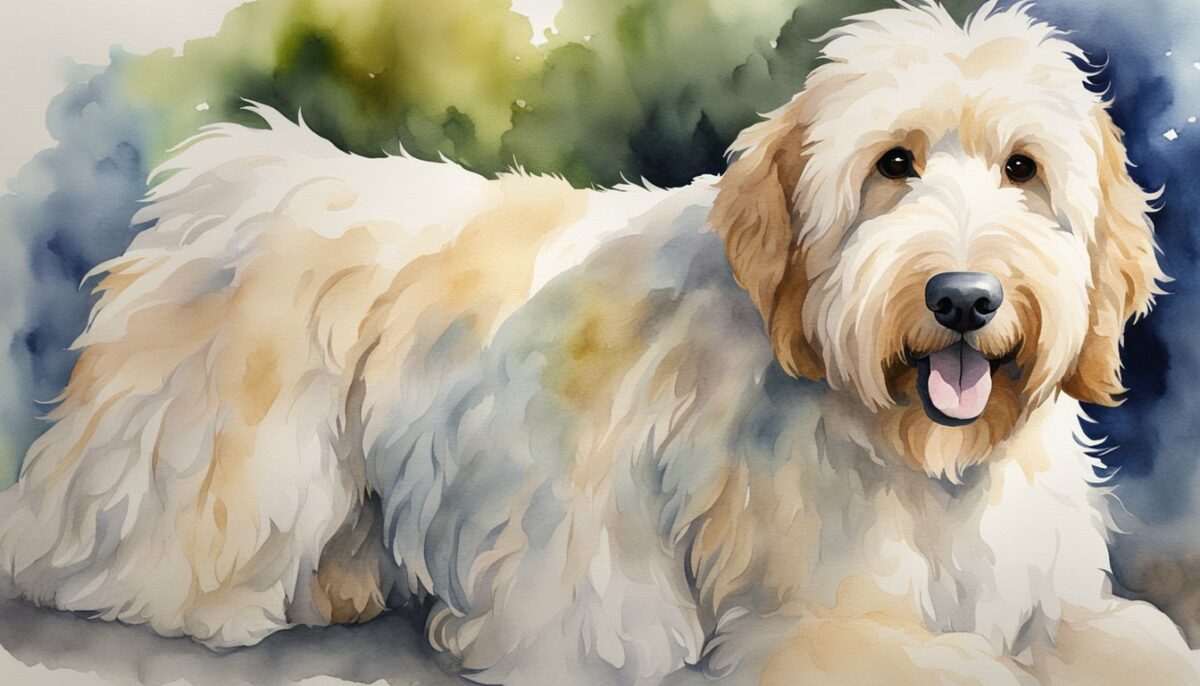
When considering the health of Goldendoodles, it’s important to recognize that their coat color can be more than just a cosmetic feature.
It may also provide insights into possible genetic health issues. I’m here to discuss how coat color in Goldendoodles can influence their health from the standpoint of genetics and careful breeding practices.
Goldendoodles inherit their diverse coat colors from their Golden Retriever and Poodle lineages.
Certain colors and patterns, like merle, are linked to specific genetic traits. Merle, for instance, can sometimes be associated with auditory and ocular abnormalities if not bred correctly.
This genetic component underscores why careful breeding is critical in predictably passing on healthy genes without inadvertently promoting recessive color-linked health issues.
I also emphasize the importance of genetic testing in breeding programs. Reputable breeders perform these tests to identify and avoid passing on genes that could result in detrimental health conditions tied to coat color.
For example, specific genetic markers that indicate a predisposition for certain skin conditions can be identified through this testing.
Furthermore, regardless of their color, all Goldendoodles benefit from a well-maintained coat. Proper coat care—including regular grooming and diet to support skin and fur health—can help prevent skin issues that are not necessarily genetic but still impact overall well-being.
In summary, while coat color alone isn’t a definitive predictor of health in Goldendoodles, understanding its connection to genetic qualities allows for responsible breeding choices and informed care strategies. This knowledge helps protect the health and vibrancy of these beloved dogs.
Grooming and Care of Different Coat Colors
Goldendoodles offer an array of beautiful coat colors, ranging from dark brown to light brown, and proper grooming plays a crucial role in maintaining the vibrancy and health of your pet’s fur. I’m familiar with the specific needs of non-shedding coats, as they often require regular brushing to prevent matting.
For dark brown coats, it’s essential to use a high-quality shampoo that enhances the deep color without causing fading. Use conditioners that contain natural oils, which help keep the dark fur glossy.
Light brown coats may show dirt more easily, so I recommend more frequent baths with gentle shampoos to protect the coat’s natural oils. It’s also worth noting that lighter colors may be susceptible to discoloration; therefore, choosing products designed for color maintenance is beneficial.
Here’s a simple table outlining care routines:
| Coat Color | Brushing Frequency | Bathing Frequency | Product Tips |
|---|---|---|---|
| Dark Brown | 2-3 times a week | Every 4-6 weeks | Enhancing shampoos |
| Light Brown | 2-3 times a week | Every 3-4 weeks | Gentle, natural shampoos |
When dealing with non-shedding coats, I always advise to start grooming routines early in your Goldendoodle’s life. This gets them used to the process, making it a more pleasant experience for both of you.
In some cases, a Goldendoodle’s fur might change over time, including instances of hair turning white. To understand why these color changes occur, you might want to learn more about the hair turning white phenomenon.
Maintaining your Goldendoodle’s coat through proper grooming and care will not only keep them looking their best but also contribute to their overall well-being.
Regular grooming sessions are vital, and I always make sure to approach these sessions with patience and care, ensuring that my Goldendoodle feels comfortable and safe throughout the process.
Breeding Strategies for Desired Colors
When I embark on the journey to produce puppies with specific coat colors, I follow a methodical approach to breeding Goldendoodles.
My primary focus is on genetics, as the coat color of a Goldendoodle is determined by the genes inherited from the parent dogs. Careful breeding is paramount to ensure not only the desired color but also the health and vitality of the puppies.
In designing a breeding plan, I consider the following:
- Genetic Basics: Understanding the dominant and recessive color genes that the parent dogs carry is essential. For example, if I aim for puppies with a red coat, I need to prioritize red and apricot genes in the lineage.
- Coat Type Evaluation: The Golden Retriever and Poodle mix can result in varying coat types, including wavy, curly, and straight. I tend to focus on pairing parent dogs that exemplify the ideal coat type that is most likely to enhance the chosen color.
My strategy involves:
- Patient Pairing: Only breed dogs that have been genetically tested to carry the desired color traits.
- Predicting Patterns: Factor in more complex patterns like parti, merle, phantom, or brindle, which can be less predictable than solid colors.
- Documenting Outcomes: Keep detailed records of breeding outcomes to refine the strategy for future litters.
Note: I always prioritize the health and well-being of the dogs over aesthetics. Ethical breeding practices are the standard I strive to maintain, considering that certain colors and patterns may be linked with health issues.
By adhering to these principles, I work towards producing Goldendoodle puppies that not only have the desired coat color but are also healthy and well-tempered.
The Role of Coat Color in Goldendoodle Adoption
When I assist families or individuals looking to adopt a Goldendoodle, I’ve found that coat color often plays a significant role in their decision-making process.
Goldendoodles, recognized for their adorable appearance and teddy bear-like qualities, come in a dazzling array of colors. Prospective pet owners frequently have a vision of their ideal doodle puppy, which includes specific coat colors or patterns.
Common Coat Colors:
- Cream
- Apricot
- Red
- Black
- Chocolate
- Parti (multi-color)
My experience tells me that lighter colors like cream and apricot are particularly sought after due to their striking resemblance to the cuddly look of a teddy bear.
Goldendoodles with these hues often catch the eye of adopters looking for that classic, heartwarming doodle puppy appeal.
In contrast, some adopters prefer the unique or rarer colors like sable, merle, or phantom, which may not be as commonly available. Their choice reflects a desire for a Goldendoodle that stands out or aligns with a personal preference for distinctiveness in their pet’s appearance.
It’s important to educate adopters that while coat color can be a fun aspect to consider, it doesn’t determine the goldendoodle breed’s temperament or suitability for a family. I emphasize to my adopters to look beyond color and focus on health, personality, and the compatibility of the Goldendoodle with their lifestyle.
Adopting a Goldendoodle with a specific coat color can add to the excitement of bringing home a new family member. However, I always stress that every Goldendoodle deserves love and a great home, regardless of their coat’s hue or pattern.
Goldendoodle Color Trends and Popularity
In recent years, my observations have led me to identify a wide array of Goldendoodle coat colors which have surged in popularity.
From my perspective as a dedicated enthusiast, it’s fascinating to see how trends emerge in Goldendoodle coat colors, influenced by both aesthetic preferences and the breed’s charming personality.
Popular Goldendoodle Colors:
- Apricot: I’ve noticed this soft creamy red color is one of the most sought after. It radiates a warmth that’s slightly more intense than cream yet not as deep as red. It’s also recognized by the American Kennel Club in Poodles.
- Black: A striking solid black Goldendoodle remains less common, but I find its strong hue attracts admirers who prefer a stark contrast to the typically lighter shades.
- Chocolate: While not the most prevalent, chocolate Goldendoodles have their own following. I’ve seen these lovely brown tones lighten over time, capturing interest from those who appreciate the rich, evolving shades.
From my research and participation in various Goldendoodle associations, I’ve compiled a list reflecting current trends:
| Color Group | Examples |
|---|---|
| Lighter Shades | Cream, Apricot, Gold |
| Darker Hues | Black, Chocolate, Silver |
| Rare Varieties | Phantom, Parti, Brindle |
These trends don’t just speak to the aesthetic but also to the diversity within the breed. I find that prospective owners often seek a color that resonates with their personal style or stands out in the canine crowd.
The Goldendoodle’s popularity doesn’t hinge solely on their coat’s color, but it certainly plays a role in the appeal. My conversations with owners affirm that while they may be initially drawn to a particular color, it’s the Goldendoodle’s affectionate and intelligent nature that truly captures their hearts.